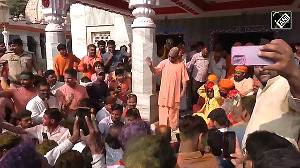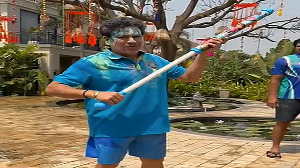Time the Shiv Sena and the Maharashtra Navnirman Sena cease talking about protecting the Maharashtrian asmita (pride) when they talk in support of fighting the influx of job-seeking migrants. Instead they should come clean on the fact that the present concern with regard to migrants is only economic.
Time also they proclaim that it is all about ensuring that the fruits of development are for the locals alone and that they do not want to share it with others. For, the issue of asmita and the jobs-for-the-locals-alone campaign are two different things altogether.
And it is equally an opportune moment for other political parties, and notably some elders in it like Chhagan Bhujbal and Narayan Rane, to jump on the same bandwagon. They too, like the MNS and the Sena, would then be riding two horses.
Let me explain. In my opinion, asmita that is talked about in the political domain has little to do with what is happening. That asmita, and bread and butter, are two different strands of life.
Asmita is all about one's identity, and from that identity, the pride that emerges. It is all about the self-pride and the self-worth thereof. And such identities have the cultural and the civilisational aspect subsumed into it.
In other words, fighting for the Marathi manoos is not fighting for his asmita.
Not weak
It is not such a weak thing, this asmita, that it would just get evaporated, weakened or eroded by the influx of the migrants. Even a poor man, deprived of his share in the job market because of the continuing rush of migrants, can still manage to retain his identity. At least, the self-pride part of it.
That asmita, intangible in one sense, gets eroded only when in an un-Maharashtrian manner you take to the streets, beat up people or in the least, scare them away.
Maharashtrians are not violent by nature. They may argue -- the tendency is best described by the Marathi words chikitsak vritthi, of being particular, fastidious, finicky or fussy -- till they are blue in the face. They can and do so without even raising their voices; the choice of words spoken softly often conveys a sharp point of view, a rebuke, an opposition or disagreement without malice or venom, a truly unique characteristic. All done politely.
Can't be mixed
Simply because Bal Thackeray let loose his men on South Indians in the past and the Sena built its political muscle on violence does not mean that violence is acceptable. It has to be remembered that the Sena's wider support base, in collaboration with the Bharatiya Janata Party, emerged later only on the Hindutva platform. The Sena is not inclined to give that up anytime in the near future. Ask Uddhav Thackeray.
That's why it is time the practice of applying the lipstick of asmita to economic issues ceases here and now. The parties should have the political courage to admit that they are on an economic platform, plain and simple.
Anything else would be dishonest. But politics and honesty are improbable bedfellows. They do not mix, like oil and water.
Neither do asmita and jobs. Yes, jobs have a lot to do with one's well-being.
If economics is the issue, it does not need the garnish of asmita.
Most Maharashtrians would agree with the MNS and the Shiv Sena about the demand that the sons-of-the-soil should get priority in local jobs and 'outsiders' should not be allowed to edge out the locals. But, surely, not all of them would approve of the violence, whatever the provocation.
Think different
Simply because an individual is a Maharashtrian but belongs to another political ideology does not make him or her less of a Maharashtrian. It only means they think differently; believe that others who are poorly off in other regions of the country are forced to migrate to economic magnets like Mumbai.
But they are not enemies of Maharashtrians. They realise that the century-old trend of migrants making it to the city of Mumbai cannot be reversed but are worried that the locals, on their own, are unable to make their way ahead. The forward push, they think, has to be encouraged without beating the rival physically out of the city.
In a democratic society, that is not a conflict. It cannot be even seen as one.
By physically harming him and driving him back to his poorly governed state where economics mattered little, a Maharashtrian is hurting his image. The hurt is self-inflicted.
Not just Mumbai, even Delhi, Kolkata, Chennai, Bangalore, even Ahmedabad are subject to migration and its impact. Delhi has not quailed; it is a national capital, after all. Kolkata has benefited from cheap labour from eastern Bihar much as Punjab has on its green fields and Ahmedabadis have not lost their identity, especially their cultural identity.
Others evolved differently
Each city has evolved differently, responded differently and are what they are today.
I lived in Ahmedabad and heard people in businesses, even in the government, say that while the Gujarati knew how to run his business, administrative acumen, an ability to help interact with rest of the country came because of their dependence on the South Indians. In no way did their Gujaratiness -- or the Gujarati asmita -- diminish a whit.
In Chennai, now more cosmopolitan than ever, people still retain their identity, including their dressing habits of veshti and the towel at home and have not given up on their idlis and dosas. I know, asmita cannot be simplistically likened to continuing to like that fare on the table but it is a point that is sought to be made.
I was born in Hyderabad and was both Marathi and Hyderabadi. I have seen the astounding route the city took. It was a city with a distinct Dakkani culture, regardless of the citizens being Hindus or Muslims, or even among Hindus, speakers of different languages or with different caste identities. I now find it a better run place, with more jobs generated, because of the migrants who brought money and enterprise with them. So much so, there is little Dakkani spoken there, but the city has reconciled. It is all Telugu, very little of even Urdu. This city is a happy exception.
Marathi is stronger
But Marathi culture -- or identity -- is much stronger for it to happen here.
If there has to be resistance, they have to be to the inroads into culture by other cultures. But no culture can survive or sustain itself in isolation without other winds blowing on it. Guarding its strong points is both an individual's as well as a community's collective effort.
And what have we here?
There were not even whispers when Maharashtrians danced the dandiya raas or when Marathi songs were sung to Gujarati tunes during Navaratri?
And our asmita is to vulgarise Ganesh festivals by bringing in Bollywood numbers, setting aside all spiritual components of worship? The other and generous construct is to say that the culture is also assimilative.
And if assimilative, as Maharashtrians, we cannot practice exclusion.
Also assimilative
Bengalis have come, live cheek by jowl with us, don't intrude into our lives and are at peace. So are Gujaratis. Likewise, the Marwaris. Even Punjabis have brought their business strengths to the city. The Tamils, Malayalis and Telugus hardly get noticed. But it is the Hindi-speaking who is being seen as the one who thieves our rights.
Why? Why just them? Because, most of them came here to work in the informal sector, accepting any chore, any task as long as they managed to survive and improved their lot with lots of hard work. But things have been a-changing. The Biharis and UPwallas are now taking a share of the formal sector jobs as well and the political parties are getting worked up and pretend the fight is for asmita.
All wrong.






 © 2025
© 2025